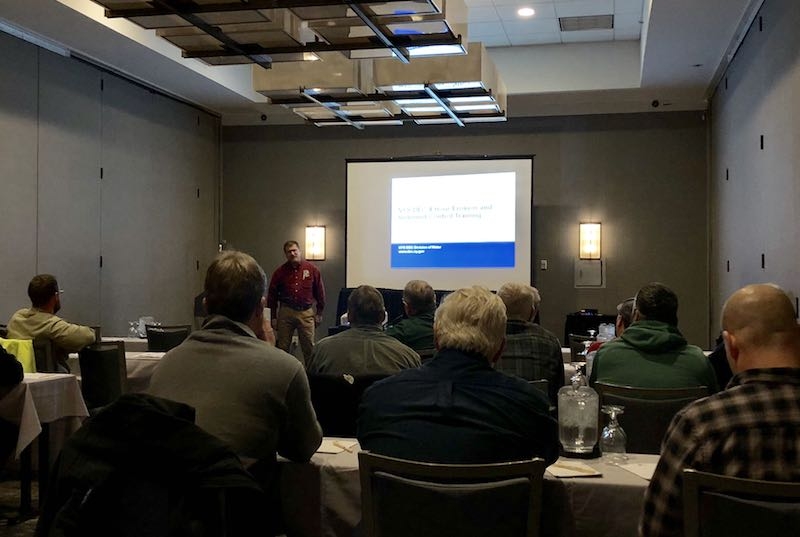
Features
Contractor at Work
Refresher on erosion and sediment control
What are the top three takeaways for drainage contractors?
January 21, 2019 By Stephanie Gordon
 Mark Burger
Mark Burger Drainage contractors are completing erosion and sediment control certification training in order to stay up to date with best environmental practices. Here are some key takeaways from a recent training session and more information on the certification.
On Jan. 7, 2019, during the New York Land Improvement Contractors of America (LICA) annual convention in Syracuse, NY, Onondaga Soil and Water Conservation District conducted a four-hour erosion and sediment control certification session for contractors.
The session covered best practices for contractors to address potential erosion and sedimentation issues. Some topics included developing a Stormwater Pollution Prevention Plan (SWPPP), establishing temporary soil stabilization methods such as covering the ground with mulch, vegetation, or tarp, and discussing must-haves for any job site.
Mark Burger, director of Onondaga Soil and Water Conservation District who helped administer the training, shared his top three take-home messages for contractors.
The first was to protect yourself with documentation. Negative impacts on water quality from a lack of erosion and sediment control are regulated, and a failure to implement best environmental practices could result in consequences ranging from fines issued to a project being shut down. Burger advised to keep a rain gauge on the job site and to monitor it daily. In addition, keep a job journal for daily notes about the project, such as the weather that day, what the crews did and what best management practices have been repaired or replaced. Finally, Burger advised using a mobile phone to take before and after photos of the repairs that have been done. Keeping this type of daily documentation can help troubleshoot a problem down the line, or be a resource for an inspector’s trip.
The second key takeaway was to work with inspectors not against them. “Please remember that [construction inspectors] are just doing their jobs, just as you are,” Burger said. “Please welcome them with open arms and show them what they need to see.”
Finally, Burger touched on the importance of erosion and sediment control in the first place. “We are the stewards of the environment . . . so please continue to do your part to keep the soil on the land, the nutrients in the soil, and get that exposed soil re-vegetated so that when the big storm hits we’re having nothing but clean water leave our project sites.”
Doug Fisher, program manager with Onondaga Soil and Water Conservation District who administered the training alongside Burger, shared his key takeaways for contractors, specifically those involved in wintertime construction. “Sometimes it’s best not to do construction in the winter time,” Fisher started. “So you want to shut down until conditions are better to do that work.”
Fisher explained it’s hard to move frozen ground, so contractors will cause a lot more disturbance. It might be best to wait until the ground is thawed and can be worked efficiently. “If you are going to do winter shutdown, the thing to be concerned with is snow management. Where do you put the snow, how do you check the site, how do you check the practices that you have installed, or have partially installed, to make sure that they’re still performing until you can get back onto the job in the springtime?” Fisher said.
To make sure practices are working properly, appoint somebody within your company to be accountable to visit the site and check it after every significant rainfall event or warm up where there’s been significant snow melt. If a problem is noticed, that person can get the right tools and right personnel in there to fix it, Fisher continued.
In addition to staying up-to-date with best practices, Burger encouraged contractors to reach out to their local soil and water conservation district or conservation authority for assistance and guidance during a project. Burger emphasised these conservation bodies are non-regulatory and have years of experience that can help provide ideas to solve a problem. “We’re not going to tell you what to do or how to do changes if you’re having problems with a component of a site, but we can spin ideas and help you go back to the project inspector and the other team leaders with ideas or alternatives on corrective measures to be able to get the site back on track, and keep the project going on time and on budget,” Burger said.
In the state of New York, erosion and sediment control training is required every three years. The New York Department of Environmental Conservation partners with county Soil and Water Conservation Districts across the state to administer the four-hour erosion and sediment control training course. A full training calendar is available online, listing the times and locations of upcoming sessions.
For other states, training opportunities can be found on the EnviroCert international Inc. website or local environmental authority. The Certified Professional in Erosion and Sediment Control (CPESC) program was created more than 25 years ago and the certification is now required by numerous local governments, state governments and provinces, and is recognized in some state construction general permits. In some states, it is a requirement that at least one person on a project is certified.
The Erosion and Sediment Control Association of Canada provides training for contractors north of the border and is the Canadian affiliate licensed to register and deliver the EnviroCert International Inc. certification programs. There are three programs, including certifications in erosion and sediment control, stormwater quality, and as an erosion, sediment and stormwater inspector. A list of upcoming training events is available on their website. There will also be a Soil Erosion Control Contractors Certificate Renewal Workshop at the upcoming Land Improvement Contractors of Ontario annual convention, held in London, Ont. from Jan. 22 to 24, 2019.
Print this page